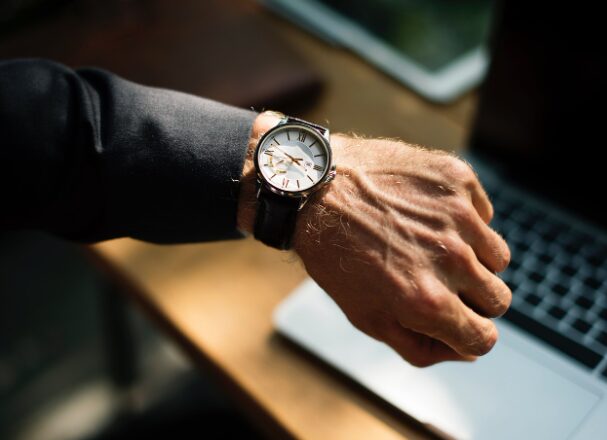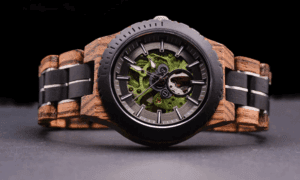Your watch represents more than just a timekeeping device—it’s a precision instrument that demands proper care to maintain its accuracy and aesthetic appeal. Professional watch servicing can cost hundreds or thousands of dollars, making preventive maintenance essential for protecting your investment.
This comprehensive guide reveals industry-proven techniques used by professional watchmakers to extend timepiece longevity, based on decades of horological expertise and real-world testing.
Understanding Your Watch Movement Type
Before implementing any care routine, identifying your watch’s movement type is crucial, as each requires different maintenance approaches.
Mechanical Watches
Hand-wound mechanical movements contain approximately 130 delicate components working in harmony. These timepieces require the most careful handling and regular attention to their winding mechanism.
Automatic Watches
Self-winding movements feature a rotor that winds the mainspring through wrist motion. The additional complexity of the rotor system requires specific care considerations not found in manual-wind watches.
Quartz Watches
Battery-powered movements are generally more robust but still require protection from magnetic fields and extreme temperatures that can affect the electronic components.
The movement type directly impacts your servicing schedule, daily care requirements, and environmental sensitivity levels.
Daily Care Fundamentals
The 30-Second Evening Routine
Develop this simple habit that prevents 80% of common watch damage:
Step 1: Remove your watch before washing hands or applying lotions. Even water-resistant timepieces can suffer from soap residue and chemical exposure.
Step 2: Wipe the case and bracelet with a microfiber cloth to remove skin oils, perspiration, and daily debris. Pay special attention to the case back and bracelet links where buildup commonly occurs.
Step 3: Check the crown position. Ensure it’s fully pushed in and screwed down (if applicable) to maintain water resistance integrity.
Crown Handling Mastery
The crown is your watch’s most vulnerable component. Improper handling causes more damage than any other factor.
Critical Technique: Always unscrew the crown counterclockwise first, then pull gently. Never force a crown—if it resists, the threading may be damaged.
Winding Protocol: For manual watches, wind slowly with consistent pressure. Stop immediately when you feel resistance. Over-winding can break the mainspring, requiring expensive repairs.
Setting Time: Pull the crown to the correct position and turn clockwise only. This prevents reverse gear damage in the movement.
Professional Cleaning Techniques
Weekly Deep Clean Method
Professional watchmakers use this technique to maintain timepieces between services:
Materials Needed:
- Soft-bristled toothbrush (dedicated watch use only)
- Warm soapy water (mild dish soap)
- Microfiber cloths
- Compressed air (optional)
Process:
- Remove the bracelet if possible (this varies by manufacturer)
- Brush gently along bracelet links and case edges
- Rinse with clean water (water-resistant watches only)
- Dry immediately with compressed air and microfiber cloth
- Allow 24 hours for complete moisture evaporation
Chemical Exposure Prevention
Common household chemicals that permanently damage watch components:
- Perfumes and colognes contain alcohol that degrades rubber gaskets
- Cleaning products can discolor metal and damage coatings
- Sunscreen creates residue that attracts dirt and affects water resistance
- Lotion and oils penetrate bracelet links and case seals
Professional tip: Apply personal care products 10 minutes before putting on your watch, allowing them to fully absorb.
Water Resistance and Moisture Protection
Understanding Water Resistance Ratings
Water resistance ratings are often misunderstood, leading to costly water damage:
30m/100ft: Splash resistant only—not suitable for swimming or showering 50m/165ft: Light swimming acceptable—avoid diving or water sports 100m/330ft: Swimming and snorkeling safe—not for diving 200m/660ft+: Suitable for recreational diving
The Hidden Moisture Threat
Temperature extremes and UV radiation compromise gasket integrity over time. Even water-resistant watches can experience moisture infiltration if gaskets aren’t maintained.
Critical Warning Signs:
- Condensation under the crystal
- Foggy appearance that doesn’t clear
- Unusual ticking sounds
- Crown difficulty when winding
If you notice any of these symptoms, immediately stop wearing the watch and seek professional service.
Temperature and Environmental Considerations
Extreme Temperature Effects
Watches face constant temperature challenges that affect accuracy and component longevity:
High Temperature Damage:
- Lubricants thin out, causing excessive wear
- Gaskets expand and lose sealing effectiveness
- Electronic components in quartz watches malfunction
Low Temperature Problems:
- Lubricants thicken, affecting movement accuracy
- Metal components contract, creating gaps
- Battery performance decreases in quartz movements
Safe Operating Range: Most watches function optimally between 32°F-140°F (0°C-60°C).
Magnetic Field Protection
Modern life presents unprecedented magnetic exposure risks:
High-Risk Sources:
- Smartphone speakers and magnets
- Laptop computers and tablets
- Magnetic closures on bags and cases
- MRI machines and security scanners
Protection Strategy: Keep watches at least 4 inches away from magnetic sources. Consider anti-magnetic watch storage solutions for watches for doctors and healthcare professionals who face increased magnetic exposure.
Proper Storage Solutions
Professional Storage Principles
Proper storage prevents more damage than any other single factor:
Primary Storage Requirements:
- Consistent temperature (65-75°F ideal)
- Low humidity (45-55% relative humidity)
- Protection from magnetic fields
- Cushioned support for the case
Watch Winder Considerations
For automatic watches, proper winding maintenance is essential during storage periods. A quality best watch winder provides consistent movement without overwinding, particularly important for watches with complex complications.
Winder Selection Criteria:
- Adjustable turns per day (TPD) settings
- Bidirectional winding capability
- Quiet operation for bedroom placement
- Multiple power settings for different movements
Professional Servicing Schedule
Manufacturer vs. Reality-Based Servicing
Luxury automatic or mechanical watch service interval is every three-to-five years, but real-world factors affect this timeline:
Accelerated Service Needs:
- Daily wear in harsh environments
- Frequent water exposure
- Impact or shock exposure
- Accuracy drift beyond acceptable limits
Extended Service Intervals:
- Occasional wear patterns
- Careful handling and storage
- Stable environmental conditions
- Consistent accuracy maintenance
Service Quality Indicators
Choose service providers based on these professional standards:
Certification Requirements:
- Factory-trained technicians
- Genuine parts availability
- Proper testing equipment
- Warranty on service work
Red Flags:
- Extremely low pricing
- Quick turnaround promises
- Inability to provide service documentation
- Lack of proper insurance
Common Mistakes That Damage Watches
The Seven Deadly Sins of Watch Care
- Shower Wearing Even water-resistant watches suffer from soap residue and steam exposure that degrades gaskets prematurely.
- Crown Forcing Attempting to force a stuck crown causes thread damage requiring expensive case replacement.
- Magnetic Exposure Placing watches near phones, laptops, or magnetic closures magnetizes the movement, causing accuracy problems.
- Chemical Contact Perfumes, cleaning products, and lotions contain chemicals that permanently damage cases and movements.
- Impact Neglect Dropping watches or impact exposure can displace internal components, affecting accuracy and functionality.
- Improper Storage Storing watches in humid, hot, or magnetically active environments accelerates component degradation.
- Delayed Service Ignoring accuracy problems or water resistance issues leads to compound damage requiring complete overhauls.
Specialized Care for Different Watch Types
Luxury Mechanical Watches
High-end mechanical timepieces require specialized attention:
Daily Protocol:
- Hand-wind consistently at the same time
- Avoid rapid date changes between 10 PM and 2 AM
- Monitor accuracy daily for early problem detection
- Store in controlled environment when not worn
Sports Watches
Active lifestyle timepieces face unique challenges:
Post-Activity Care:
- Rinse with fresh water after salt water exposure
- Clean perspiration immediately to prevent corrosion
- Check gaskets regularly for wear signs
- Test water resistance annually
Vintage Timepieces
Older watches require conservative care approaches:
Preservation Strategies:
- Minimal handling and winding
- Professional service only by vintage specialists
- Avoid water exposure regardless of original ratings
- Document condition changes with photographs
Emergency Care and Troubleshooting
Water Damage Response
If your watch experiences water infiltration:
Immediate Actions:
- Stop wearing immediately
- Do not attempt to wind or set
- Place in rice container to absorb moisture
- Seek professional service within 24 hours
Never Attempt:
- Hair dryer heating
- Freezer placement
- Movement operation while wet
Accuracy Problems
When your watch gains or loses time significantly:
Diagnostic Steps:
- Monitor accuracy over 7 days
- Check for magnetic exposure
- Note environmental conditions
- Document any impact events
Service Indicators:
- Gaining/losing more than 30 seconds per day
- Intermittent stopping
- Unusual sounds during operation
- Difficulty winding or setting
Professional Maintenance Investment
Understanding service costs helps plan maintenance budgets:
Typical Service Costs:
- Quartz movement: $75-150
- Basic mechanical: $200-400
- Luxury mechanical: $400-800
- Complicated movements: $800-2000+
Cost Factors:
- Movement complexity
- Case material and construction
- Water resistance testing requirements
- Parts availability and pricing
Conclusion
Professional watch care combines daily attention with strategic maintenance planning. The techniques outlined in this guide, developed through decades of horological expertise, will significantly extend your timepiece’s lifespan while maintaining optimal performance.
Remember that preventive care costs significantly less than reactive repairs. Implementing these professional techniques protects your investment while ensuring your watch continues providing accurate timekeeping for decades.
Your watch deserves the same attention to detail that went into its creation. By following these expert protocols, you’re not just maintaining a timepiece—you’re preserving a piece of mechanical artistry that can last generations with proper care.



































